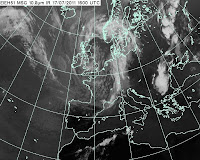Weather Balloons:
Weather balloons were first used over a century ago and were used to establish the presence of the stratosphere and tropopause. This equipment consists of a latex balloon, a parachute and a radiosonde which hangs below.
Similarly to the weather station, the radiosonde measures temperature with a thermometer, humidity with hygrometer and air pressure with a barometer, taking continuous measurements as the balloon rises. The equipment includes a tracking device which monitors the movement and converts wind speed and wind direction. An example of a weather balloon which climbed to 93,000 feet can be viewed here;
http://www.youtube.com/watch?v=dRZJdJ-HZY8.
http://www.youtube.com/watch?v=dRZJdJ-HZY8.
Satellites:
Infra-red satellite images play a large part in determining global weather patterns and revolutionized meteorology (the study of weather) in 1960 when the first image returned to earth. The image below shows infra-red radiation over the UK. This is emitted by both clouds and the earth’s surface and gives an accurate reading of temperature. This is found using a grey scale with lighter areas of cloud indicating where the cloud tops are cooler and therefore where weather features like fronts and shower clouds are.
This has come on a long way since the first satellite image, taken in 1960. This was the beginning of the highly accurate reports produced in the modern day.
Analyses:
The data provided by weather stations, buoys, balloons and satellite imagery are all compiled into highly complex mathematical computer models. The outputs of these are the weather forecasts which are produced and shown in the media every day.
A weather forecast is produced by translating physical laws which govern weather into mathematical equations. These equations form a 3D ‘dynamical model’, an example of which can be seen below (depicting Hurricane Floyd). The information which can be input into these equations is found using the measurement methods mentioned before.
These computer models forecast how the atmosphere is most likely to react over a period of time but are constrained by technology. For example certain variables may not be considered if they aren’t input. The forecast at this stage then needs to be translated into a more universal forecast using Model Output Statistics (MOS) equations. These are calculations which look at past model outputs and actual weather. By including actual weather this helps to provide a more accurate and localised forecast. A human forecaster will calculate the MOS equations and make a comparison with the computer model. This can then be used to make an accurate expectation of the weather.







